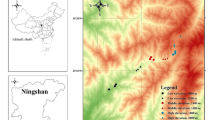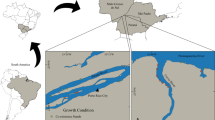Abstract
In a Mediterranean patchy wetland of central Italy, we analyzed the relationship between the number of bird species, expressed in terms of bird alpha diversity, and plant alpha diversity, expressed as Hill number. This number (the exponential of the Shannon entropy) is considered one of the most strong and reliable indexes of alpha-diversity, synthesizing the information on evenness, richness and diversity in one single metric. We observed a progressive increase of the mean values of bird alpha diversity when plant alpha diversity increases along Hill number. Bird alpha diversity shows an abrupt increase between the first and the second of four categories of plant alpha diversity (0–1, >1–2, >2–3, >3), indicating a threshold response in all the groups considered (breeding, wintering and total bird assemblages). This marked decline of bird species richness at around 1 in the Hill index should represent an alarm for managers: wetland sites at or below this level of plant alpha diversity are likely to be experiencing a drastic decrease in bird species richness, both in spring (breeding birds) and in winter (wintering birds).

Similar content being viewed by others
References
Battisti C 2006 (eds) Biodiversità, gestione, conservazione di un’area umida del litorale tirrenico [Biodiversity, management and conservation of a wetland of Tyrrhenian littoral]. Gangemi editore—Provincia di Roma, Assessorato alle politiche agricole e dell’ambiente, Rome
Battisti C, Fanelli G (2011) Does human-induced heterogeneity differently affect diversity in vascular plants and breeding birds? Evidences from three Mediterranean forest patches. Rend Fis Acc Lincei 22:25–30
Battisti C, Sorace A, De Angelis E, Galimberti C, Trucchia N (2004) Waterbird abundance in a residual wetland of Central Italy during 2 years of contrasting water level. Avocetta 28:86–90
Battisti C, Aglitti C, Sorace A, Trotta M (2006) Water level and its effect on the breeding bird community in a remnant wetland in Central Italy. Ekologia (Bratislava) 25:252–263
Bennett AF, Radford JQ (2009) Thresholds, incidence functions, and species-specific cues responses of woodland birds to landscape structure in south-eastern Australia. In: Villard M-A, Jonsson BG (eds) Setting conservation targets for managed forest landscapes. Conservation Biology series, vol 16. Cambridge University Press, Cambridge, pp 161–184
Bibby CJ, Burgess ND (1992) Bird Census Techniques. Academic Press, London
Blasi C, Michetti L (2005) Biodiversita e Clima [Biodiversity and Climate]In: Blasi C, Boitani L, La Posta S, Manes F, Marchetti M (eds), Stato della biodiversita in Italia, Contributo alla strategia nazionale per la biodiversita [The biodiversity in Italy, a contribution to the national strategy of biodiversity]. Ministero dell’Ambiente e della Tutela del territorio, Fratelli Palombi editori, Roma, pp. 57–66
Buckland ST, Studeny AC, Magurran AE, Newson SE (2011) Biodiversity monitoring: the relevance of detectability. In: Magurran A, McGill BJ (eds) Biological diversity. Frontiers in measurement and assessment. Oxford University Press, Oxford, pp 25–36
Collins SL, Glenn SM (1997) Intermediate disturbance and its relationship to within- and between-patch dynamics. New Zeal J Ecol 21:103–110
Connell SL, Glenn SM, Gibson DJ (1995) Experimental analysis of intermediate disturbance and initial floristic composition: decoupling cause and effect. Ecology 76:486–492
Cowardin LM, Carter V, Golet FG, Laroe ET (1979) Classification of wetlands and deepwater habitats of the United States. FWS/OBS-79/31—Fish and Wildlife Service, USDI
Dytham C (2011) Choosing and using statistic. A Biologist’s guide. Wiley-Blackwell, UK
Elezentiene L (2011) Alpha-diversity of differently managed agroecosystems assessed at a habitat scale. Polish J Environ Stud 20:1387–1394
Flinn KM, Lechowicz MJ, Waterway MJ (2008) Plant species diversity and composition of wetlands within an upland forest. Am J Bot 95:1216–1224
Gray JS (2000) The measurement of marine species diversity, with an application to the benthic fauna of the Norwegian continental shelf. J Exp Mar Biol Ecol 250:23–49
Hill M (1973) Diversity and evenness. A unifying notation and its consequences. Ecology 54:427–432
Honnay O, Hermy M, Coppin P (1999) Effects of area, habitat diversity and age of forest patches on plant species richness in Belgium, and consequences for conservation and reforestation. Biol Conserv 87:73–84
Jost L (2006) Enthropy and diversity. Oikos 113:363–375
MacArthur RH, MacArthur JW (1961) On bird species diversity. Ecology 42:594–598
Magurran A (2004) Measuring biological diversity. Island press, New York
Magurran A, McGill BJ (2011) Biological diversity. Frontiers in measurements and assessments. Oxford University Press, Oxford
Malavasi R, Battisti C, Carpaneto GM (2009) Seasonal bird assemblages in a Mediterranean patchy wetland: corroborating the intermediate disturbance hypothesis. Polish J Ecol 57:171–179
Mitsch WJ, Gosselink JG (2000) Wetlands, 3rd edn. Wiley Inc, New York
Rotenberry JT (1985) The role of habitat in avian community composition: physiognomy or floristics? Oecologia 67:213–217
Roth RR (1976) Spatial heterogeneity and bird species diversity. Ecology 57:773–782
SPSS Inc, 2006. SPSS for Windows (Version 15.0). SPSS Inc, Chicago
Sutherland WJ (2006) Ecological census techniques. Blackwell Science, Massachussets
Villard MA (2009) Designing studies to develop conservation targets: a review of the challenges. In: Villard MA, Jonsson BG (eds) Setting conservation targets for managed forest landscapes. Conservation Biology series, vol 16. Cambridge University Press, Cambridge, pp 30–49
Villard M-A, Jonsson BG (eds)(2009) Setting conservation targets for managed forest landscapes. Conservation Biology series 16, Cambridge University press, Cambridge
Whittaker RH (1972) Evolution and measurement of species diversity. Taxon 21:213–251
Wiens JA (1989) The ecology of bird communities. Foundations and patterns, vol I. Cambridge University Press, Cambridge
Zacchei D, Battisti C, Carpaneto GM (2011) Contrasting effects of water stress on wetland-obligated birds in a semi-natural Mediterranean wetland. Lakes Reserv 16:281–286
Acknowledgments
The authors would like to thank the rangers of the protected area (E. De Angelis, C. Galimberti, N. Trucchia) for the support in the field study. This study has been conducted within the activities of the Environmental Service—Province of Rome, that manage ‘Torre Flavia’ Natural Monument (LTER—Long Term Environmental Research—research Station). We wish to thank to Dr.Ph.D. Alessandro Zocchi for a careful reading of the English language.
Author information
Authors and Affiliations
Corresponding author
Rights and permissions
About this article
Cite this article
Fanelli, G., Battisti, C. & Malavasi, R. Comparing alpha-diversity between plants and birds in a remnant wetland: evidence for a threshold and implication for management. Wetlands Ecol Manage 22, 565–569 (2014). https://doi.org/10.1007/s11273-014-9353-7
Received:
Accepted:
Published:
Issue Date:
DOI: https://doi.org/10.1007/s11273-014-9353-7




